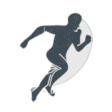SLAP tears are a relatively common shoulder injury, involving the superior glenoid labrum, which may result in pain and loss of function. The labrum is a fibrocartilaginous structure surrounding the glenoid. A portion of the long biceps tendon attaches to the superior labrum and therefore may be involved in injury. The overwhelming majority will respond to conservative treatment, but a small percentage have pain and continued functional deficits that result in surgery.
I was recently asked to give a presentation on SLAP tears and this serves as a good time to review some key points. SLAP stands for superior labral anterior posterior and was a termed coined by Dr Steven Snyder in 1990. It describes the anatomic location of the injury ie. the superior labrum extending anterior and posteriorly. Sometimes described by similar location on a clock face, a SLAP tear would involve approximately the 10 – 2 o’clock position.
Here are five key points
1. Arthroscopy remains the gold standard for diagnosis, MRI is second best.
2. There is no pathonomonic clinical exam… meaning a doctor cannot make a definitive diagnosis based off examination alone. (See #1)
3. SLAP tears are frequently associated with other pathology… such as rotator cuff, biceps tendon or the acromioclavicular joint.
4. SLAP tears are more commonly associated with overhead athletes and those involved in overhead activities. Falls onto outstretched arms and traction injuries are also frequent mechanisms of injury.
5. Surgical manangement requires repair with suture anchors versus proximal biceps tenodesis. The latter surgery being performed when the biceps tendon is torn or for revision surgery.





